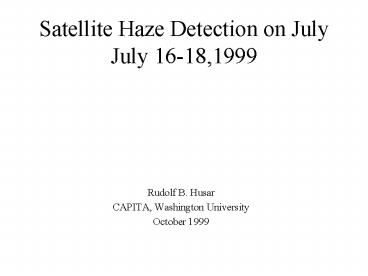Satellite Haze Detection on July July 16-18,1999 - PowerPoint PPT Presentation
1 / 6
Title:
Satellite Haze Detection on July July 16-18,1999
Description:
Rich Poirot at Vermont and and Mario Benjamin have established that that July 16 ... salts, the particles would likely deliquesce from crystals to droplets as the ... – PowerPoint PPT presentation
Number of Views:31
Avg rating:3.0/5.0
Title: Satellite Haze Detection on July July 16-18,1999
1
Satellite Haze Detection on July July 16-18,1999
- Rudolf B. Husar
- CAPITA, Washington University
- October 1999
2
The Haze Episode of July 16-18,1999
- Rich Poirot at Vermont and and Mario Benjamin
have established that that July 16-17 was a major
PM2.5 episode in the Northeastern US and
Southeastern Canada. - Doug Westphal at the Naval Res. Lab has
assimilated numerous data sets, and shown through
a model that the haze on July 16 at Cape Cod was
most likely sulfate from long range transport. - This work adds to the haze analysis by examining
the color SeaWiFS satellite data, using a
co-retrieval approach to simultaneously derive
the haze optical characteristics and also to
reconstruct the haze-free reflectance of the
surface. - This early report on the July 16 satellite haze
data analysis is shared for the purposes
cooperation in analyzing this haze event.
3
SeaWiFS Image of July 16, 1999
- At noon on July 16, the ocean near the northeast
coastline was free of clouds. However, a haze
pall was observed from Delaware to Maine. - The image is truecolor, synthesized from the
red, green and blue channels of the SeaWiFS 8
channel sensor. Scattering due to air is removed
to highlight the haze.
4
Haze and Mist Patch Near Cape Cod
Within the thicker haze defined here as mist, the
slope of the spectral AOT is low (blt0.5) compared
to the lighter haze (bgt1.0). This indicates
larger particles (D0.6 um) in the mist.
The aerosol optical thickness, AOT is 0.3
(blue) over the much ocean surrounding Cape Cod.
However, just to the the south, patches of
thicker haze are seen, with AOT gt 0.5.
The blue areas of low Angstrom exponent (larger
particle size) indicate sharply delineated
patches of mist near Nantucket and Marthas
Vineyard Islands.
5
Surface Meteorological Data at Marthas Vineyard
- In the afternoon between noon and 8 PM, the
relative humidity has increased from 50 to over
80. - During that time, the reported visibility
decreased from 10 mile (or higher) to 6 miles
corresponding to a rise in Bext from 2.4 to 4.0
km-1. - Hence, the rise in Bext is likely due to the the
rising humidity. - If the aerosol was composed of sulfate salts, the
particles would likely deliquesce from crystals
to droplets as the RH increases from 50 to 80.
6
Summary of Haze Conditions
- A haze plume from Eastern North America extended
over the East Coast between Delaware and Maine. - Over sharply defined patches near Cape Cod, the
haze turned into a thicker mist. The mist is
distinguished from haze by more intense
scattering and white appearance compared to
bluish haze. - The above is based on SeaWiFS color satellite
observations at local noon. - Meteorological data show that between noon and 8
PM the surface relative humidity has increased
from 50 to 80 and the visibility declined from
(over) 10 to 6 miles. - Any ideas on this? Write to me
rhusar_at_me.wustl.edu































